
The Percolozoa are a group of colourless, non-photosynthetic Excavata, including many that can transform between amoeboid, flagellate, and cyst stages.
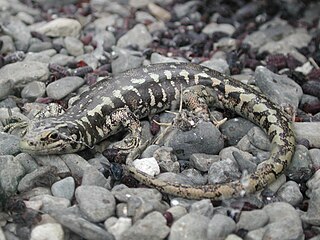
Oligosoma is a genus of small to medium-sized skinks found only in New Zealand, Norfolk Island and Lord Howe Island. Oligosoma had previously been found to belong to the Eugongylus group of genera in the subfamily Lygosominae; the Australian genus Bassiana appears to be fairly closely related.

Orycteropodidae is a family of afrotherian mammals. Although there are many fossil species, the only species surviving today is the aardvark, Orycteropus afer. Orycteropodidae is recognized as the only family within the order Tubulidentata, so the two are effectively synonyms.

The beardfishes consist of a single extant genus, Polymixia, of deep-sea marine ray-finned fish named for their pair of long hyoid barbels. They are classified in their own order Polymixiiformes. But as Nelson says, "few groups have been shifted back and forth as frequently as this one, and they were recently added to Paracanthoptergii". For instance, they have previously been classified as belonging to the Beryciformes. They are of little economic importance.
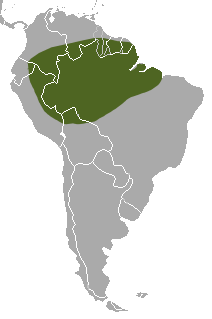
The Amazon weasel, also known as the tropical weasel, is a species of weasel native to South America. It was first identified from a museum specimen mislabelled as coming from Africa, hence the scientific name.

The Hominini form a taxonomic tribe of the subfamily Homininae ("hominines"). Hominini includes the extant genera Homo (humans) and Pan and in standard usage excludes the genus Gorilla (gorillas).
The giant tree-rat is a species in the family Echimyidae, the spiny rats. It is the only species in the monotypic genus Toromys. It is endemic to Brazil, where it occurs in the flooded forest along the banks of the Amazon River and its tributaries.

Proechimys is a genus of South American spiny rats of the family Echimyidae. All species of the genus are terrestrial. In the lowland Neotropical forests, Proechimys rodents are often the most abundant non-volant mammals. They are recognizable by reason of their elongated heads and long rostra, large and erect ears, narrow and long hind feet, and tails always shorter than head-and-body lengths. The dorsal pelage comprises a mixture of expanded, varyingly stiffened spines — hence the vernacular name of spiny rats — and soft hairs.
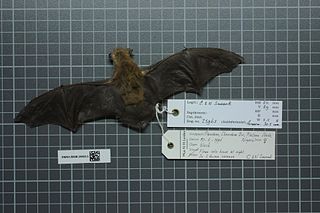
Neoromicia is a genus of vesper bat in the family Vespertilionidae. It contains the following species:

The Choco broad-nosed bat is a species of bat in the family Phyllostomidae. It is native to Colombia, Panama, and Ecuador, where it is found in the Choco region lowlands. It is threatened by habitat loss. In 2013, Bat Conservation International listed this species as one of the 35 species of its worldwide priority list of conservation.

Laephotis is a genus of bats in the family Vespertilionidae. Species within this genus are:
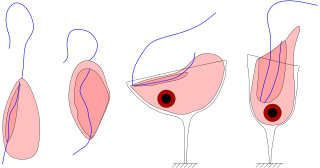
Jakobids are an order of free-living, heterotrophic, flagellar eukaryotes in the supergroup Excavata. They are small, and can be found in aerobic and anaerobic environments. The order Jakobida, believed to be monophyletic, consists of only twenty species at present, and was classified as a group in 1993. There is ongoing research into the mitochondrial genomes of jakobids, which are unusually large and bacteria-like, evidence that jakobids may be important to the evolutionary history of eukaryotes.

Thaumatomonadida is an order of flagellates.

Colpodella is a genus of alveolates comprising 5 species, and two further possible species: They share all the synapomorphies of apicomplexans, but are free-living, rather than parasitic. Many members of this genus were previously assigned to a different genus - Spiromonas.

Ancyromonadida or Planomonadida is a small group of biflagellated protists found in the soil and in aquatic habitats, where they feed on bacteria. Includes freshwater or marine organisms, benthic, dorsoventrally compressed and with two unequal flagellae, each emerging from a separate pocket. The apical anterior flagellum can be very thin or end in the cell membrane, while the posterior flagellum is long and is inserted ventrally or laterally. The cell membrane is supported by a thin single layer teak and the mitochondrial crests are discoidal / flat.
Burton's yellow-shouldered bat is a species of leaf-nosed bat found in Panama and Costa Rica.

Sturnira bakeri is a species of bat found in South-America.

Neogale is a genus of mustelid native to the Americas, ranging from Alaska south to Bolivia. Members of this genus are known as New World weasels.
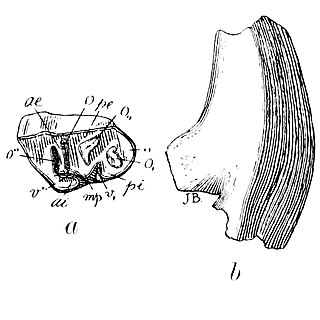
Argyrohippus is an extinct genus of notoungulate, belonging to the family Notohippidae. It lived from the Late Oligocene to the Early Miocene, and its fossilized remains were found in South America.
















